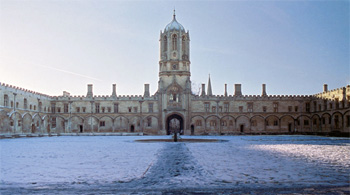The Middle Ages in Europe, a feudal society
Glossary Feudal Society: The stage of society that preceded capitalism, during which a small elite (the aristocracy) demanded recompense from a peasantry in exchange for military protection. In Europe this was the middle ages period.
The Middle Ages in Europe are the years between about 410 AD and 1500 AD. At the time that the other empires you read about in this section were at their height, Europe was quite isolated from the rest of the world, and was divided into many small states.
Europeans were ignorant of the rest of the world. Most Europeans believed that the world was flat and that is was dangerous to sail close to the edge. They believed in sea monsters and that strange and weird people lived in other parts of the world.
People’s religious beliefs were more important to them than the country that they lived in. The Roman Catholic Church was a very rich and powerful social institution in Europe. At its head was the Pope, who lived in the Vatican City in Rome. The Church owned land, and people had to pay some of their wages as taxes to the Church. It influenced what people believed about the world. The Church taught people that life on earth was not important. Almost everyone in Europe belonged to the Catholic Church and believed in God and the devil. The teachings of the Church were based on very strict rules. People were punished severely for breaking these rules. Priests also told people that they could make sure of a place in Heaven if they did not break these rules.
Universities were also important social institutions at the time. The reason universities had an important influence was that learning took place there. Only a small number of men had enough money to go to university. Very few people in Europe could read or write. Books were very expensive and scarce. Most books were written in Latin, a language not spoken by most people, but used in the universities and the Church.
The most powerful and wealthy group of people in Europe were called the aristocracy or the nobility. They were made up of a few hundred families who owned most of the land in Europe. They lived in big castles and had hundreds of people working for them and living on their land. Most members of the aristocracy did not work for a living. The aristocracy did not see themselves as ordinary people; rather they believed they had special or ‘noble’ blood. You could only become a member of the aristocracy if you were born into a noble family. There were many revolts by peasants against the harsh conditions under which they lived and worked, but these revolts were crushed without mercy.
The death penalty was used for major crimes such as murder, treason, counterfeiting and arson as well as for theft in the Middle Ages. Each year hundreds on people were hanged. Executions were always in public. The rulers of the time believed that if you wanted to stop people from committing a crime, the punishment should be as harsh as possible.
Activity: The black death: plague and the consequences Read this paper by Walter S. Zapotoczny titled ‘The Political and Social Consequences of the Black Death, 1348 – 1351’ (PDF) and discuss the consequences of the plague in class, listing them in your note book or on the board.
 Tom Quad at Christ Church, Oxford. Oxford University, Cambridge University, and many other universities were founded around this time. Picture source: wikipedia
Tom Quad at Christ Church, Oxford. Oxford University, Cambridge University, and many other universities were founded around this time. Picture source: wikipedia
A new era: changes in Europe bring about changes all over the world
After the Middle Ages in Europe, the European Renaissance began to take place in the 15th and 16th centuries. During that time there was a re-birth of learning, and new developments took place in many areas of life. During the Renaissance, people at universities started asking some very good questions about the world around them. Some of their ideas led to important changes in science, art, language and education and also led to some challenges to the power of the Church.
The European Renaissance was going to change the way Europe interacted with the rest of the world, as feudalism was changing and we see a new middle class emerging. European trade led to the establishment of fortified trading stations and eventually permanent European settlements in the Americas, Africa and India.
Read a detailed lesson on ‘the impact of colonialism’ in the grade 4 archive.
The following information will still be developed for this topic:
- Travel and trade across Europe and the Baltic Sea
- Art, science and technology: the Renaissance
- Changes in feudalism: emerging middle class
Please contribute activities and content for this section by clicking on the contribute button.


